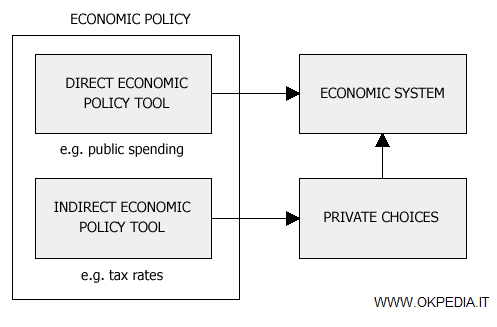Economic Policy
Economic policy is a field of economics that examines and evaluates the effectiveness of regulatory tools and government interventions within the economic system to achieve specific goals.
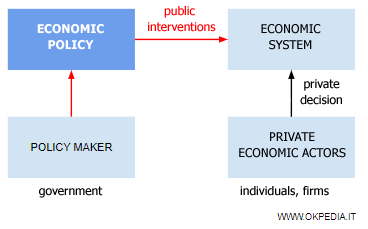
An economic policy involves a series of public interventions by the state and government (policymakers) in the economy.
Public intervention assumes that the economic system cannot naturally achieve certain goals or outcomes on its own.
This necessity prompts policymakers to implement corrective measures aimed at adjusting the economic balance.
The Purpose of Economic Policy
Generally, the goal of public intervention in the economy is to enhance overall social welfare.
Note: The objectives of economic policy are determined by policymakers and may sometimes conflict with the broader public interest. Policymakers might choose to pursue specific, narrow interests, leading to what are known as government failures.
In order to intervene in the economy, policymakers need to identify both the objectives and the tools to achieve them.
- Objective: The policymaker selects a specific target to reach (e.g., increasing consumption).
- Tool: The policymaker decides which instruments to use to achieve that goal (e.g., lowering taxes).

Economic Policy in Market Economies
In a market economy, economic policy interventions primarily serve as guidelines, as economic phenomena are driven by the actions of private individuals and businesses.
The policymaker (the state) influences private decisions through indirect tools, allowing individuals and businesses the freedom to make their own economic choices (e.g., what to buy, what to produce).
Example: Reducing taxes increases consumers' disposable income. However, this does not necessarily lead to increased consumption, as consumers may choose to save the additional income instead (a concept known as liquidity preference).
In certain situations, the state intervenes directly in the economy using direct tools, acting through state-owned or state-controlled companies.
Economic Policy in Centralized Economies
In a centralized economy (a non-market economy), the state takes full control of production and consumption decisions through central planning.
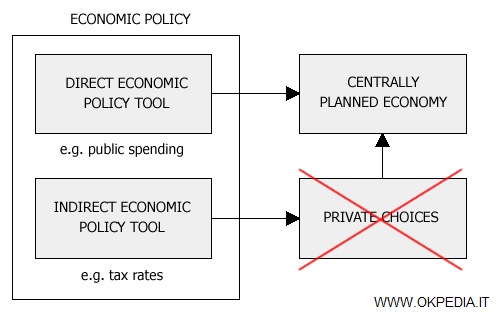
Here, the decision-making power of private individuals is reduced to a minimum.
Thus, in planned economies, economic policy mainly relies on direct tools.
The Policymaker
A policymaker is a national or international public entity (public authorities).
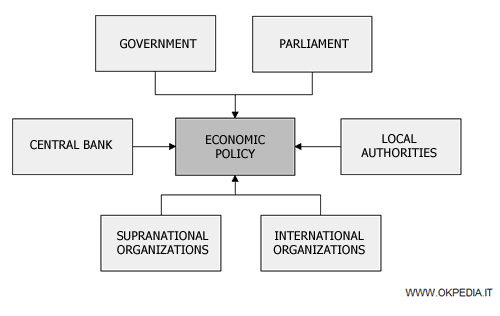
The key actors that shape a country's economic policy include:
- The State (Parliament, Public Administration, etc.)
- The Central Bank
- The Government
- Local Authorities (Regions, Provinces, Municipalities, etc.)
- International and Supranational Organizations
Examples include the International Monetary Fund (IMF), the World Bank (WB), the United Nations (UN), and the European Union (EU).
Goals of Economic Policy
The objectives of economic policy are shaped by the needs of society at a particular point in time. They can vary widely, including:
- Economic growth
- Employment
- Income distribution
- Inflation control
- Economic development
- Public finance stabilization
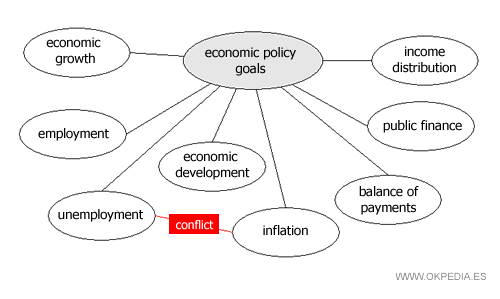
By "society," we refer to all socio-economic actors involved in the life of a country (businesses, households, and the state).
Examples of Objectives: Interventions may aim to correct market or government failures, remove obstacles to a free market (liberal economic policies), or steer the economy towards political, growth, or stability goals, such as reducing unemployment.
Based on the time frame, objectives can be classified into:
- Short-term objectives: Achievable within a few months or years. For example, counteracting rising inflation is typically a short-term goal.
- Long-term objectives: Achievable over several years. For example, an economic development policy usually involves long-term strategies.
Tools of Economic Policy
The main instruments of economic policy are fiscal policy and monetary policy.
- Fiscal Policy: This is the aspect of economic policy that explores how public spending and taxation can be used to intervene in the economy. Fiscal policy is a tool for promoting economic growth. In the IS-LM model, it affects the IS curve.
- Monetary Policy: This branch of economic policy examines how monetary leverage, money supply, liquidity, and credit influence the economy. It is typically used by the central bank to pursue economic stability. In the IS-LM model, monetary policy affects the LM curve.
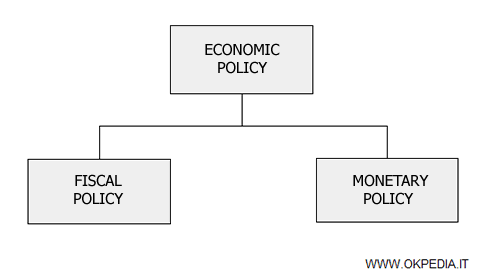
There is extensive literature on economic policy, with various schools of thought offering different perspectives.
Schools of Economic Policy
The main schools of economic thought in the 20th century are the Keynesian and monetarist schools.
Which Economic School is More Effective? The effectiveness of economic policies depends heavily on the historical context, the country's macroeconomic situation, and the economic system in which they operate. Therefore, no single economic policy theory can be deemed universally effective across different times and places.
Method of Analysis
Economic policy uses normative analysis as its primary method of investigation.
This sets it apart from other branches of political economy that rely on positive analysis.
Difference Between Macroeconomics and Economic Policy: Macroeconomics is the positive branch of economics that studies economic phenomena as they are. In contrast, economic policy is a normative branch that explores techniques and tools to change the economic reality and steer it toward a desired direction.

